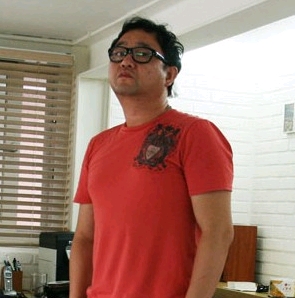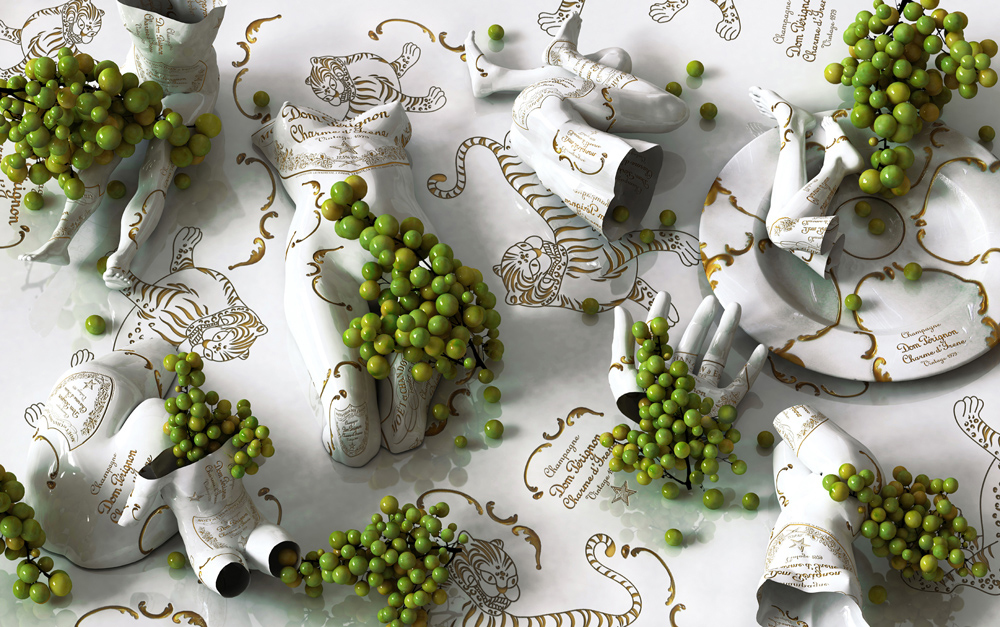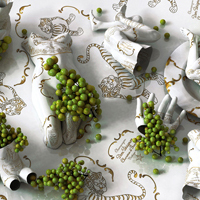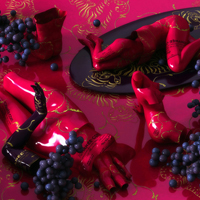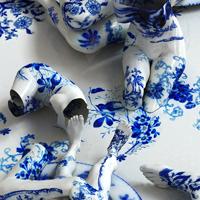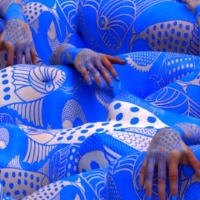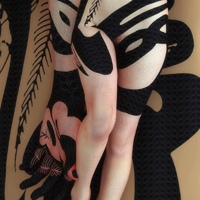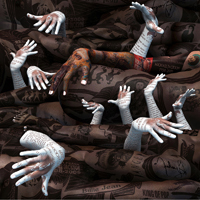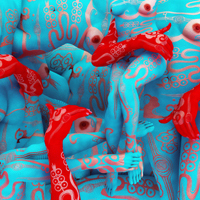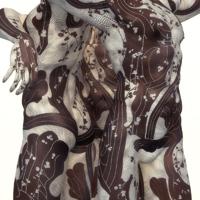Kim Joon’s Works - Fetish, a Stifling Feast of Fleshes
The human body is a tool for self-expression. We can identify its archetypal image in body language, in other words, the language of gestures. When tattoos, body paintings, and piercings are added, in addition to acquiring a decorative style, the image obtains a more obvious form of visual information or sign beyond mere self-expression. Through this process of drawing on and decorating the human body as canvas, the body has become the forefront of expression and a facade of language and signs.
In particular tattoos are deeply related to male culture with its inheritance of patriarchy as legacy. For instance, a tattoo of the slogan “Just Do It” satirizes an overbearing military culture. A hidden tattoo in the shape of a heart carved on a lover’s private body part reflects a sexual fetish that considers the lover an object of one’s possession. A dragon-shaped tattoo that covers the whole body of a yakuza triggers a sense of danger and fear. On the other hand, in various types of sub-cultures, tattoos signify and function as an icon of a culture of anomaly confronting a culture of normality, a kind of resistant gesture. Finally, tattoos, including stickers easily attached and detached from the body, have now become a distinct mode, transcending the boundary of taboos about the body and traversing the boundary of negative perception and social prejudice. Thus, tattoos are self-expression and, most of all, cultural signs elaborately engraved with individual and social desires, a mapping of desires of the era. This is why Joon Kim focuses on tattoos and how his works acquires meaning.
It is already well over a decade since Joon Kim started working with tattoos as subject matter in the mid 1990s. At first he made “synthetic flesh lumps” onto which he carved tattoos. He made objects stuffed with cotton or sponge encased with cloth or synthetic leather, then partially backstitched these pieces into objects, and proceeded to carve all kinds of tattoos on the surfaces. Later, his method evolved into digital printing of images completed through “mouse painting” that drew bodies and then coated them with tattoos on a computer or projected as video images. Whereas the tattooed flesh lumps by the first method created a sense of heterogeneity and foreignness as if looking at actual pieces of flesh, the later virtual images offer more delicate, sensual, sexy, and refined impression.
Joon Kim’s work draws attention because of the artist’s particular understanding and interpretation of tattoos as well as the uniqueness of his subject matter. Tattoos in his work do not reference typical common sense associations. They are fetish signs of capitalism and of a society of consumption--such as the logos of Adidas, Starbucks, Gucci, Chrysler, Ferragamo, Armani, Christian Dior, and Prada; individual and collective ideologies and faiths like that of the Red Devils or a particular political party; tastes of a sub-culture reflected in a fan club like that for Jimi Hendrix; and childhood memories reflected in comic books like Superman. Each of us is imprinted with conscientized (meaning “made aware of important social and political issues”) tattoos acculturated to certain faiths, signs, and tastes. These tattoos indicate desires of the individual, the collective, and of the era. The artist regards the desires that dominate people’s consciousness, and sometimes even permeate their unconscious, as a kind of conscientized and socialized tattoo.
Conscientized tattoos refer to what has been cemented as consciousness. Here, tattoos externalize consciousness, in other words, embody its material form. When desires are mounted on our consciousness, both become objects. For example, the sentence, “I desire Ferragamo” means that I, my consciousness, my body desires Ferragamo. Therefore, the material form of such desires leaves their vivid marks on my body, as well as on my consciousness. Fetishism, in other words, is materialization of non-materials. What I desire is elaborately carved onto my body. Kim’s delicate, lifelike images on 3D digital prints effectively, persuasively, and vividly illustrate the tattoo of desires and their social contexts elaborately carved onto my body.
Desires toward Ferragamo are engraved on the body through the brand’s own logo and design, and further transcribed onto the skin with its innate texture. Therefore my body itself transforms into a Ferragamo and is displayed like a product. My whole identity becomes Ferragamo. The fabricated body in the artist’s works is more elegant and attractive than a real body due to the very non-humanization or dehumanization process wherein humans and their individuality are transformed into products. Naturally, products are always more attractive than reality, and images are always more refined than reality. Capitalism’s scheme is focused on the commercialization and image creation of the world and it is perhaps natural for such a world to be alluring. In actuality, the shadow of decadence always wavers before one’s eyes, but products do not have such shadows. Perhaps the plot of capitalism is to erase such shadows, and to that effect capitalism may be based on a fantasy industry. Bodies depicted as images and virtual flesh that diffuse desires and acquire attractive goods imply the artist’s response to this fantastic, virtual, and, most of all, inhumane and post-human reality.
Desires are seductive, and in discussing the mechanisms of seduction, the sexual fetish deserves mention. Joon Kim’s work suggestive of such fetishes is the Bubble Series, which is produced in both digital print and video formats. This series shows the dualism or ambivalence of desire, or sexual fetish. The respective colors of pink and ivory on the body are sensuous and sexual, while the bubbles that resemble blisters or tumors swollen on the surface of the body appear morbid. Eros and Thanatos, the personification of Eros’ shadow, were collapsed into a single scene, which may be interpreted as a message against capitalism opting to erase shadows from reality. Another possible interpretation a la Jacques Lacan is the notion of the bubbles as unexpected appearance of the real world (shadow of reality) into the symbolic.
Rather than merely responding to capitalism and the desires it produces, Kim maintains a dual and ambivalent attitude. Hell, a three dimensional artwork, and Prajna, a video work whose theme is also Buddhist, could be such examples. In Prajna, which portrays Buddhist figures with large and small craters erupting here and there on the skin surface, the figures and the craters on the skin (symbolizing desire) conflict with each other. In Buddhism, desire is the origin and cause of all kinds of pain. It is the very nature of existence, the cause of karma. Without desire, there is no karma. However, humans cannot escape from desire. It is not about governing desire outside the realm of desires, but the emancipation of the self and individual journey to attain enlightenment.
In Kim’s latest works, he expands the scope of his work and adopts earthenware as subject matter. He places fragmented body parts where capitalism’s figures and icons of the era have been elaborately carved, tattoos of food on tableware. In this series, the artist lays out a very provocative interpretation of desire, and of sexual fetishes; he uses direct narration as a way to establish humans as objects of greed and voracity (for example, I want to eat you). A stifling feast of flesh is shown as sexual fetish, capitalist desire targeting commercialization of individuality is finally developed into the format of a meal, and desires become conspicuous in this process.
In fact, such capitalist desires are more fundamental in some of his works, such as those featuring bodies without faces. A body without a face is a body whose persona has been castrated and therefore a body whose commercialization has been thoroughly realized, implying the indiscrimination of capital. The artist also plays on the variations of this indiscrimination of capital in the form of bricolage. In other words, all kinds of heterogeneous things are hybrids that have been combined and synthesized into a single whole and target a compounded objecthood totally different from reality, resembling a virtual reality phenomenon. Instead of re-presenting, re-acting, re-identifying a knowable reality, a new reality and a virtual actuality are created. Therefore, although the appearance resembles a sensuous reality, in fact it heads towards a different dimension, one that opens up to a banquet of bodies looking like the fantasy industry of capitalism. In the end, his works may be read as a simple response to the fantasy industry, but also as a more aggressive strategy to implode capitalism by monopolizing indiscrimination--capitalism’s innate syntax (for example, as attempts to dismantle the commercialized body by applying indiscrimination excessively).
Chung-Hwan KHO(Art Critic)






